 Pirates and Privateers Pirates and Privateers
The History of Maritime
Piracy
Cindy Vallar, Editor
& Reviewer
P.O. Box 425,
Keller, TX 76244-0425
    
Books for Adults ~ Nautical Fiction
The
Captain's Nephew
A Sloop of War
On the Lee Shore
A Man of No
Country
The Distant
Ocean
The Turn of the
Tide
In Northern
Seas
Larcum Mudge
Upon the
Malabar Coast
Clay and the
Immortal Memory
Clay and
the River of Silver
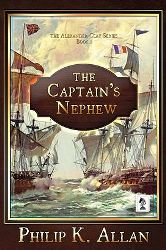
The Captain’s Nephew
By Philip K. Allan
Penmore, 2017, ISBN 978-1-946409-36-2, US $19.50
Also available in e-book format
    
During the Royal Navy’s
assault on Ostend, First Lieutenant
Alexander Clay is tasked with leading a
shore mission to prevent the garrison of
French troops at Nieuwpoort from
reinforcing Ostend. The straightforward
plan is to land, blow up a bridge, and
wait for HM Frigate Agrius to
return to retrieve them. The plan goes
awry almost from the start. Not only must
he play nursemaid to his captain’s
inexperienced nephew, but getting to their
objective is fraught with complications no
one expects, their arrival is noticed, and
the uncooperative weather and water
conditions prevent an easy recovery.
Clay’s ingenious idea for getting his men
back to their ship saves them from capture
and they return to England to await their
next assignment.
Captain Percy Follet’s report of the
incident, which soon finds its way into
the newspaper, gives credit for the
incident not to Clay, but to his nephew,
Lieutenant Windham. Lacking an influential
mentor and not coming from a wealthy
family, Clay fumes at the injustice done
him. His only hope of advancement and
gaining his own command is through his
initiative and accomplishments. It grates
that the undeserving-of-his-rank second
lieutenant should garner the accolades
that rightfully belong to him. When he
questions Captain Follet about this
injustice, a rift develops between the two
men.
The Agrius’s next assignment is to
escort a convoy of East Indiamen part of
the way to India. The commander of the
merchant ships invites all the navy
officers aboard his vessel for a formal
dinner, much to the chagrin of Clay. He
much prefers the regimented wooden world
in which he lives and never knows what to
say to women. He is pleasantly surprised
to find that one of the ladies, Lydia
Browning, is a friend of his sister and,
by evening’s end, he’s captivated by
Lydia. In the days that follow they become
closer, but on the night he decides to
declare his intentions, Captain Follet
orders him to remain on Agrius. A
marriage between Clay and Miss Browning is
totally unsuitable, and her uncle has
asked the captain to intervene. Thus the
rift between Clay and his commanding
officer widens, and soon the crew becomes
aware of it. The majority support Clay.
Once the Agrius bids farewell to
the merchant convoy, she heads west to
take up her new station in the West
Indies. She is also tasked with finding
and destroying a larger, more powerful
French frigate bound for the island of St.
Lucia and carrying much-needed stores and
troops. In spite of his anger, Clay
efficiently carries out his duties, but
Follet’s resentment of his first officer
leads to complications that endanger the
ship and their mission.
The Captain’s Nephew opens with a
mesmerizing and vivid portrayal of a man
drowning and then regresses six months to
show the events that culminate in this
tragic incident. From first page to last,
Allan bewitches and transports readers
back to 1796 to walk the decks of a wooden
ship and engage the enemy all the while
experiencing what the characters endure.
Equally compelling is that this is not
just a tale of the officers of the Royal
Navy. Interludes are woven into the story
to personalize and recreate life on the
lower decks, as well as to provide
glimpses of what it was like for loved
ones left behind. This first book in the
Alexander Clay series offers a satisfying
resolution of who dies, while only hinting
at how it happens – an intriguing and
perfect enticement for readers who will
eagerly await the next chapter in Clay’s
pursuit of his naval career and the woman
he loves.
Review Copyright ©2018 Cindy Vallar

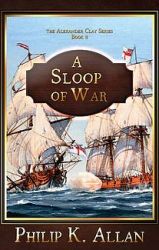
A Sloop of War
By Philip K. Allan
Penmore, 2018, ISBN 978-1-946409-42-3, US $19.50
e-book ISBN 978-1-946409-43-0, $5.50
    
When
HM Frigate Agrius limps
into Barbados with a larger French
warship as her prize, Vice-Admiral
Benjamin Caldwell is both dismayed
and delighted. Her damage is such
that she must undergo immediate
repairs rather than allowing the
commander of the Windward Islands
station to implement his plan to
seize the French island of St.
Lucia. The saving grace is that
First Lieutenant Alexander Clay has
acquired some intelligence that will
aid in that endeavor. His actions in
battle against a mightier foe and
assuming command after the death of
his captain earn Clay a promotion to
master and commander and a vessel of
his own, the sloop of war Rush.
Finally, he has climbed the first
two rungs of the social ladder that
may raise his status as a suitable
husband in the eyes of his beloved’s
guardian. But Lydia is in far off
India and Clay can only dream of the
day when they may once again
reunite. Until then, he forges a
plan with his sister in England. She
will hide his letters in her
packages to Lydia.
In the meantime, Clay
sails the Rush to St.
Lucia with orders to blockade one
of the island’s ports. The sloop’s
sluggish response does not bode
well for the assignment, but
there’s little he can do to remedy
the mass of seaweed and barnacles
that foul her hull as long as they
are at sea. The lack of speed
allows an enemy merchant ship to
slip past Rush into the
safety of the harbor protected by
the guns of the French fort.
Clay’s anger at losing a potential
prize gives rise to a daring plan
to remedy the loss – one that
requires him to trust that his men
can carry out it, for as captain,
he must remain aboard Rush.
The night attack proves successful
and a prize crew sails the
merchant ship back to Barbados.
Clay follows at a slower pace,
which proves far more dangerous
than expected when they encounter
a 74-gun Spanish man-of-war whose
captain wants the Rush as
his prize.
While the main focus
of this second book in the
Alexander Clay series focuses on
the British invasion of St. Lucia
in the 18th century, A Sloop
of War is entwined with
several other tales. Lieutenant
Nicholas Windham still blames Clay
and his best friend, John Sutton,
for the death of his uncle, the
captain of the Agrius, and
is determined to make them pay one
way or the other. Able Sedgwick, a
runaway slave, seeks refuge at
Spring Hill Plantation, where the
enlightened owner has freed his
slaves, while making himself and
his family pariahs among the
plantocracy. To thwart Barbadian
law George Robertson arranges for
Able to join the Royal Navy and
sail aboard the Rush. An
ardent abolitionist, Jacob
Linfield, Rush’s surgeon,
strikes up a friendship with
Robertson and becomes enamored
with his younger daughter, who
seems more attracted to John
Sutton.
A Sloop of War
is a fast-paced nautical adventure
interwoven with land and sea
actions, as well as civilian,
political, and historical
elements. Alexander Clay may be
the main character of this book,
but Able Sedgwick is a likable
fellow who easily takes center
stage more than once. His
integration into the crew deftly
shows life in the Royal Navy,
while at the same time
demonstrating both acceptance and
prejudice among a cast of
characters where each is uniquely
drawn and rarely stereotypical.
The energy in the confrontation
between Windham and Clay feels
like being shocked by static
electricity. Several scenes are
laced with humor, and the
wonderfully descriptive comparison
in the final engagement perfectly
allows readers to imagine what is
unfolding. Fans of nautical and
naval fiction will enjoy this
second entry in the series and
will look forward to the next
phase in Alexander Clay’s career
and love life.
Review Copyright ©2018 Cindy
Vallar


On the Lee Shore
By Philip K. Allan
Penmore, 2018, ISBN 978-1-946409-48-5, US
$19.50
Also available in e-book format
    
A
summons from the Admiralty
signals the end of Captain
Alexander Clay’s convalescence
after being wounded in a sea
battle in the Caribbean. Upon
his arrival in London, he learns
of the discontent rippling
through the Royal Navy. The
ranks are dissatisfied with
their pay – which hasn’t been
raised in over a century – poor
rations, and no leave when ships
are in port. Such disgruntlement
can’t be swept under the rug
either, for the crew of HM
Frigate Titan take
matters into their own hands.
They lock up the officers and
refuse to obey any orders from
their captain, accusing him of
murder and misuse. The First
Lord decides that he needs an
intelligent officer with dash to
assume command of this warship
and Clay is just the man.
When Clay first
steps aboard the 36-gun
vessel, he sees only hostile
faces. Many are angry. Some
are contemptuous, others
indifferent. His orders are to
restore order and discipline
aboard Titan, but he
prefers menial labor and
constant drilling to achieve
this, rather than the lash as
his predecessor favored. Clay
also permits music and other
lively entertainment among the
men when they’re off duty.
Regardless of these easements,
there are those who remain
discontent. One is an officer
who favors the stricter
enforcement of Titan’s
former commander. Among the
ranks, there is a cadre of men
led by Richard Sexton, an
Irishman and an avid adherent
of the United Irishmen. He’s
not above using trickery and
violence to achieve his goals,
which includes once again
taking control of the ship.
A few officers
and a handful of men know Clay
and transfer with him to Titan.
Those of the lower decks
discover how the United
Irishmen communicate with each
other when posted to different
ships. They also are
determined to prevent Sexton
and his group from succeeding
in their endeavor, especially
when a message is intercepted
that informs those on board
the Titan that the
ranks have staged a mutiny,
based in Spithead, that has
essentially brought the navy
to a standstill at a time when
they can least afford one.
Titan is
one of a squadron a warships,
under the command of Commodore
Sir Edward Pellew, blockading
the French navy port of Brest.
Clay is tasked with making
daily sails close to port to
check on the comings and
goings of the fishing fleet,
the French navy, and any other
intelligence that may be of
interest. The more havoc he
can cause, the better, but his
daring, unconventional sorties
require officers and crew to
work in unity. Complicating
each plan are the dangerous
waters in which they patrol
and the dirty weather that
frequently hampers and
endangers them. When a
particularly violent storm
scatters the fleet, Clay and
his men must make the French
continue to think the whole
squadron remains on blockade.
But the danger aboard remains
and it only requires a single
match to ignite.
On the Lee
Shore is the third entry
in the Alexander Clay series
and is filled with action and
peril that keeps readers on
the edge of their seats. Allan
provides a unique perspective
of the Spithead Mutiny,
splitting his depiction
between the points of view of
the officers and men. He
deftly intertwines avarice,
corruption, and mutiny, while
spicing these with glimpses
into the everyday lives of
sailors and their personal
lives both at sea and at home.
There’s even a bit of romance,
as Clay and Lydia Browning
finally reunite.
Review Copyright ©2018 Cindy
Vallar

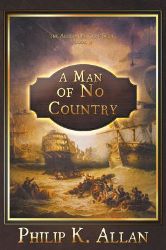
A Man of No
Country
By Philip K. Allan
Penmore, 2018, ISBN
978-1-946409-60-7, US $19.50
e-book ISBN
978-1-946409-61-4, US $5.50
After marrying
the love of his life, Captain
Alexander Clay finds his
idyllic shore leave cut short.
His frigate, Titan, has
been repaired; instead of
rejoining the Channel Fleet,
he and his men sail for the
Mediterranean to assist
Admiral Lord St. Vincent.
Rather than the boring voyage
expected, they investigate
suspicious actions aboard a
merchant brig and discover
that pirates control the
vessel and the crew is locked
below. After rescuing the
captives, they later spot a
Russian sloop that runs
aground rather than fight.
When Clay’s men reach the
shore, one of the evaders
turns out to be John Grainger,
who claims to have been forced
to navigate for the Russian
privateers. Although he
dresses like a Turk, was
raised in Algeria, and has
their coloring, he speaks
English and has piercing blue
eyes. He just claims not to
know where he was born. Once
aboard Titan, he joins
the Royal Navy.
When they arrive
on station, Clay meets with
the admiral. He and his
vessels maintain a blockade on
the Spanish navy, which means
no naval ship has ventured far
into the Mediterranean.
Therefore, Titan is
to become the eyes of the
fleet. Clay will find out
what’s happening, what the
French are planning, and visit
Ambassador Hamilton in Naples.
While the ship
resupplies and their captain
meets with the admiral, Sam
Evans, Adam Trevan, Joshua
Rosso, and Sean O’Malley,
along with John Grainger,
visit a tavern. Able Sedgwick
arrives late, having stopped
to purchase a blank journal in
which to record his life’s
story as an African slave to
help the abolitionist cause.
John mistakes the journal for
his own and accosts Able. The
serving girl notices John’s
tattoo and becomes terrified.
When Able later questions her,
she divulges the true meaning
of the mark.
Once the Titan
returns to sea, she
becomes enshrouded by a dense
fog and those aboard find
themselves surrounded by the
Spanish fleet. Since they
remain invisible to the enemy,
Clay tricks two of the vessels
into firing upon each other.
It’s a neat trick, but he
regrets how he endangered his
mission. He soon puts his
reckless misstep behind him,
when he sends his men ashore
to seize a merchant ship that
eluded them and to launch a
surprise attack on an enemy
fortification. In doing so,
they discover the captured
prize carries military tents
and cooking equipment bound
for Marseille.
Upon their return
to the ship, Sam discovers
that he’s been robbed. More
thefts soon follow, and Able
overhears one of the new men
threatening someone. No matter
how much searching the master
of arms does, he finds no
trace of the missing money or
the thief. To keep the growing
discontent from endangering
the ship, Clay enlists Able’s
help in discovering the truth.
As Titan ventures
past numerous harbors, Clay
has lookouts count the ships
in the harbor. When combined
with the tents and cooking
equipment, it soon becomes
evident that General Napoleon
Bonaparte is amassing an
enormous fleet. Clay
immediately returns to report
to the admiral to find that
Rear-Admiral Horatio Nelson
has arrived with
reinforcements. Clay joins his
squadron and they set out to
determine where the French
plan to go. When Titan revisits
the harbors, Clay discovers
the French fleet has
disappeared. It soon becomes a
battle against time to find
out where Bonaparte intends to
launch his next invasion.
A Man of No
Country is the fourth
offering in the Alexander Clay
series. The eye-opening
prologue is a powerful and
horrifying depiction of a
Barbary pirate attack, where
the merchant captain warns his
young son that should he be
captured, he must join the
pirates in order to survive,
but his request comes at an
excruciatingly high price.
Discovering the identity of
the thief proves to be a
challenging mystery for the
reader. We also learn more
about Able’s traumatic and
chilling journey from Africa
to the Caribbean. A bit of
humor is inserted into scenes
where Clay meets Lady Emma
Hamilton, and Allan does a
fabulous job in making the
reader experience Clay’s
awkwardness and discomfort at
becoming prey to her feminine
wiles. There is also a daring
sea rescue in the midst of a
terrible gale. All the
adventures lead up to the
stunning and breathless sea
battle between the Royal and
French Navies that history
knows as the Battle of the
Nile.
Review Copyright ©2019 Cindy
Vallar

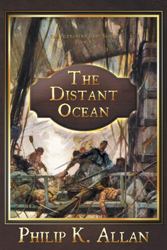
The Distant Ocean
By Philip K. Allan
Penmore, 2018, print ISBN
978-1-946409-78-2, US $19.50
e-book ISBN 978-1-946409-79-9, US $5.50
    
Three
French ships plague
British merchantmen in
the Indian Ocean, and
the mounting losses
necessitate the
departure of Captain
Alexander Clay from
his wife. Their
parting is
bittersweet; his
orders come just as he
learns of his
impending fatherhood,
and he may be gone a
long time. Duty,
however, takes
precedence, and he
joins Commodore Sir
George Montague’s
squadron. In addition
to their two warships,
which are tasked with
ending the French
depredations, are two
sloops. One is
commanded by his
closest friend, John
Sutton, and the other,
by their nemesis,
Nicholas Windham.
Windham has never
accepted the story of
how his uncle died,
and he craves justice.
“Dismal George” –
better known for his
penchant for his
ship’s appearance than
his fighting
capabilities –
overlooks some of
Windham’s
disgruntlement, but
cannot abide
dissension among his
officers. He fears
that Windham’s idée
fixe will cause
injury to his own
career and orders his
friend’s nephew to set
aside the need to make
Sutton pay and
reconcile.
On their way to their
destination, Clay
escorts several
Guineamen to the Gold
Coast, while Dismal
George and the sloops
accompany another
convoy to Gibraltar.
Floating corpses off
Africa introduce Clay
and his men to one of
the horrific realities
of slavery and, when
the truth of what
occurred is
discovered, Clay sets
in motion a scheme to
thwart the French
privateer responsible
for the deaths.
Coxswain Able Sedgwick
plays a key role in
the plan, for he grew
up on these shores,
but the outcome has
unforeseen and deadly
consequences.
The initial blockade
of Reunion Island, a
French stronghold in
the Indian Ocean,
fails to lure the
enemy warships from
their safe haven. Clay
and Sutton have words
over the latter’s
intentions toward
Clay’s sister, causing
a rift between the
friends. Then Wyndham
puts forth a new plan
to deal with the
French that Sutton
supports. Their two
sloops will ferret out
the weakest of the
three enemy vessels
and launch a
two-pronged attack.
During the hunt,
Dismal George will
escort a convoy to
Bombay while Clay
accompanies another
ship – one already
attacked by the French
– to Cape Town.
Wyndham’s gambit has
definite merit, but
his motivation differs
from Sutton’s, much to
his chagrin.
The Distant Ocean,
the fifth book in the
Alexander Clay series,
is an incisive and
accurate depiction of
life in the Georgian
navy. Allan
incorporates a
humorous portrayal of
a Crossing the Line
ceremony, a poignant
farewell to men lost,
and a harrowing escape
at sea into this
beguiling tale of
friendship, guilt,
obsession,
retribution, and
determination.
Review Copyright ©2019
Cindy Vallar

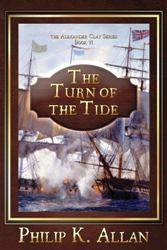 The Turn of
the Tide
The Turn of
the Tide
By Philip K. Allan
Penmore Press, 2019, ISBN
978-1-950586-01-1, US $19.50
e-book ISBN 978-1-950586-02-8, US
$5.99
    
Three
distinctive
episodes open this
sixth book in the
Alexander Clay
series. A one-eyed
Scotsman named
Major Fraser
eludes French
gendarmes with the
help of a French
royalist. Able
Sedgwick attends
an abolitionist
meeting to speak
about his
experiences as a
slave, but
hecklers disrupt
the gathering.
When things turn
ugly, Able’s mates
come from a nearby
tavern to even the
score. Captain
Clay gives away
the bride, his
sister, to his
best friend and
fellow officer at
their wedding.
Soon after,
Alexander is
summoned to London
for a special
meeting with the
First Lord of the
Admiralty.
The summons means
an end to the
brief sojourn at
home and a start
of a new mission.
Although Clay’s
frigate, Titan,
is to join the
Channel Fleet
blockading the
French coast, the
First Lord has a
detached
assignment for him
and it involves
Major Fraser. For
some time, he’s
been working with
the Choannerie,
French royalists
based in Brittany
who are determined
to upend the
revolutionary
government. The
British government
is amenable to
assisting them,
but before
becoming too
involved, Clay
must land Fraser
and several
marines, along
with a sufficient
number of rifles,
in enemy
territory. Clay
decides to send
his own trusted
marine, Lieutenant
Thomas Macpherson,
with Fraser to be
his eyes and ears.
The initial ambush
that the Choannerie
plan goes off
without a hitch.
That success
convinces the
First Lord that
one additional
show of resistance
is necessary, but
it must involve a
much larger and
more secure
target. Major
Fraser has such a
place in mind;
while he works
ashore in France,
Clay and the
Titans practice
for their part in
the attack. He has
reservations, but
places his trust
in Fraser. Tom
acquires tidbits
of knowledge that
alone are
insignificant, but
when put together
leave him quite
unsettled. While
belowdecks, a new
recruit who claims
to have psychic
powers causes a
ripple of discord
that disrupts the
happy ship.
This episode in
Alexander Clay’s
adventures takes
place both at sea
and on land. Aside
from showing life
at sea from the
perspectives of
the ratings and
the officers,
Allan weaves
interesting
subplots
throughout the
tale. One of these
is an annoying and
elusive French
privateer; another
is a cleverly
perpetrated hoax
to teach a lesson.
The climax is
stunning,
riveting, and
awesomely unveils
the treachery
behind a finely
honed plan of
vengeance. Fans of
the series will
find this book as
good as or better
than previous
titles; newcomers
will quickly
become fans eager
to discover what
happens to Clay
and his Titans.
Review Copyright
©2020 Cindy Vallar

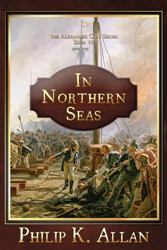
In Northern Seas
By Philip K. Allan
Penmore, 2019, print ISBN
978-1-950586-23-3, US $19.50
ebook ISBN 978-1-950586-24-0, US
$5.50
    
Napoleon
is frustrated.
He conquers
all in his
path except
one particular
thorn; the
British navy
thwarts him no
matter how he
attempts to
invade
England. One
of his
ministers
suggests an
alternative
method. Rather
than mount a
direct attack,
France will
strike where
the English
are most
vulnerable:
the canvas,
hemp, and tar
that their
warships need.
If French
agents can
persuade the
Baltic
countries to
cease selling
these supplies
to the
English,
diplomacy and
misinformation
will prove a
far better
weapon to
achieving his
dream.
The loss of a
ship,
regardless of
whether the
captain does all
that he can or
not,
necessitates a
court martial.
Captain
Alexander Clay
stands so
accused. What
puzzles him
more than the
outcome is the
civilian with
the
silver-topped
cane who
attends the
proceedings.
Glances
between that
gentleman and
the presiding
admiral,
followed by
gentle
persuading
that a
question asked
need not be
answered
strikes Clay
as odd. When
the same
gentleman
appears
unannounced at
his home and
wonders
whether he
might be
interested in
a new frigate,
Clay is
further
nonplussed.
The answer, of
course, is
yes; after
all, he is a
captain in the
Royal Navy and
the country is
at war with
France.
The gentleman
with the cane
proves to be
Nicholas
Vansittart, a
lawyer and
influential
member of
Parliament. He
is also a
diplomat who
requires
Clay’s
assistance in
his current
mission: to
stop French
interference
in the Baltic
trade. He
admires Clay’s
ability to get
the job done,
oftentimes
using
unexpected
methods, and
the manner in
which he has
advanced
through the
ranks on his
own merit.
With Clay at
the helm of a
fast ship, HMS
Griffin,
the hope is
that together
they can
resolve the
current
difficulties
through
diplomacy. If
not, Clay will
already be on
station to
assist Sir
Hyde Parker,
Lord Horatio
Nelson, and
the Baltic
Fleet in
demonstrating
just how far
the British
will go to
protect their
supply chain
against Mad
Tsar Paul’s
League of
Armed
Neutrality.
Like a ship
navigates the
swells and
troughs of the
sea, this
seventh book
in the
Alexander Clay
series keeps
readers
traversing
wave after
wave of action
and adventure.
Whether in
Paris, London,
Copenhagen, or
St.
Petersburg,
intrigue
abounds. Clay
and much of
his old crew,
as well as a
few new ones,
find
themselves in
the thick of
things. One
new character,
Vansittart’s
valet, has
ties to two of
them, neither
of whom are
particularly
pleased to
renew his
acquaintance.
To further
spice up this
nautical tale,
Allan
interweaves
humor,
romance,
bigotry,
assassination,
murder, and
theft with
coming to
terms with a
disability,
narrow
escapes, and
an enemy ship
stalking Griffin.
The denouement
is a riveting
account of the
action during
April 1801’s
Battle of
Copenhagen. It
is rife with
closer-quarter
fighting,
ships of the
line, and
Nelson’s
famous turning
of a blind
eye. Readers
will find
themselves
sitting on the
edge of their
seats, holding
their breath,
as the story
carries them
back in time
to revisit old
friends and
experience
unexpected
hazards.
Review Copyright
©2020 Cindy Vallar

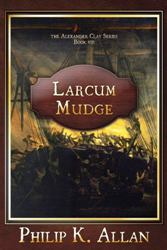
Larcum Mudge
By Philip K. Allan
Independently published,
2020, ISBN 979-8638972721,
US $19.50
    
HM
Sloop Peregrine
is an
unhappy
vessel. Her
captain brooks
not the
slightest
infraction,
and punishment
almost always
involves the
cat. The
discontent on
the lower deck
foments into
mutiny; once
in control,
the mutineers
and ship
vanish in the
Caribbean,
with no one
wise to the
brutal and
bloody
slaughter
because they
assume the
ship goes down
during a
hurricane.
With repairs
to HM Frigate
Griffin almost
complete,
Captain
Alexander Clay
attends to the
task of
recruiting for
his
undermanned
ship. A short
time after a
printer
informs him
that some
mutineers have
been captured,
a visit with
the First Lord
of the
Admiralty
reveals that
the mutineers
delivered Peregrine
to the
French. Clay
is ordered to
sail to the
Caribbean,
find the ship,
and recapture
her. If that’s
not possible,
she must be
destroyed.
There is no
other way to
erase the
stain on the
Royal Navy’s
honor. To
assist him in
this task is a
boatswain’s
mate who once
served aboard
the Peregrine
before the
mutiny.
In Plymouth, a
man encounters
mates from the
Griffin talking
outside a
tavern where
an officer is
signing on new
recruits.
Larcum Mudge
likes what he
hears and
decides to
join the navy.
His
familiarity
with life
aboard a
king’s ship
causes them to
wonder why
someone who
has spent so
much time on a
whaling vessel
never claims
to have served
aboard a
warship
before. Then,
during an
encounter with
a French
privateer,
Mudge slays
one of the
captives after
he surrenders.
It looks like
a righteous
kill,
especially
when a tattoo
on the dead
man identifies
him as a
deserter from
the Royal
Navy.
With rumors of
peace
abounding, Griffin
sails for
the Caribbean.
Upon arrival
there, Clay
has a brief
reunion with
his
brother-in-law,
who warns him
about the
mercurial
temperament of
the captain
who blockades
Guadeloupe
where Clay
hopes to find
Peregrine.
Arriving on
station, he
discovers
there is also
a French
warship in the
harbor – one
that the
blockading
captain has no
knowledge of.
Since the
fortifications
and natural
layout of the
harbor make it
impossible to
extract Peregrine,
Clay devises
an ingenious,
yet risky,
strategy to
succeed in his
mission. This
entails a
series of
orders, one of
which upsets
the blockading
captain.
During his
absence, Clay
discovers the
reason for the
outburst and,
in the
process,
captures one
of the
mutineers. In
the meantime,
Mudge and his
messmates are
among the men
tasked with
implementing
Clay’s plan.
When one does
so with a tad
more zeal than
necessary,
they become
trapped. Only
Mudge can lead
them to
safety. In
doing so, he
reveals
knowledge that
he shouldn’t
have.
This eighth
book in the
Alexander Clay
series takes
place prior to
the Peace of
Amiens in
1802. It also
represents
Allen’s first
venture into
self-publishing.
While Clay
plays an
important part
in this story
– one that
involves a
puzzle that
can reopen
wounds of a
past scandal –
it is
predominantly
a tale of the
lower decks.
Allen’s artful
recreation of
the past is
second only to
his skillful
creation of
Larcum Mudge.
The name alone
sparks
interest, but
readers soon
come to care
about this man
and what
happens to
him. Larcum
Mudge is
by far the
best book in
the series and
an adventure
that fans old
and new will
enjoy.
Review Copyright ©2020
Cindy Vallar

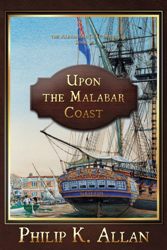
Upon the
Malabar Coast
By Philip K. Allan
Independently Published,
2021, ISBN
9798744579487, US $19.50
Also available in e-book
format
    
In
February 1803,
the world is
at peace and a
French
lieutenant has
only
information to
settle a debt.
The
information he
divulges wends
its way back
to England,
where it comes
to the
attention of
Nicholas
Vansittart.
The diplomat
extraordinaire
understands
the import of
what this
means.
Whatever is
planned most
likely
concerns the
East India
trade, which
is worth
millions to
England. To
thwart
France’s
plans,
Vansittart
requires a
fast ship with
a captain who
thinks outside
of the box and
he knows just
who will
serve.
Elsewhere in
England,
Captain
Alexander Clay
is enjoying
his
retirement,
although a
part of him
still wishes
he sailed upon
the sea. HMS Griffin,
his former
ship, is in
ordinary and
his men are
scattered.
Living in
Polwith, Adam
Trevan and
Able Sedgewick
own a fishing
boat. Adam
spends his
free time with
his family,
while Cupid’s
arrow strikes
Able.
Vansittart
intrudes into
these idyllic
vignettes and,
on his wedding
night, Able
must tell his
bride that he
and the other
Griffins are
rejoining the
navy. Together
with Clay and
Vansittart,
they are bound
for the
Malabar Coast.
Clay knows
only too well
that nothing
is ever as it
seems and
always more
complicated
than first
imagined.
Napoleon and
peace make
strange
bedfellows,
which means
the French
admiral’s true
mission
differs from
what the
informant
divulged.
Danger abounds
throughout the
journey. Able
disappears.
The Griffins
must rescue
men from a
ship on the
brink of
sinking.
Miscommunication
brings aboard
a new pet,
whose special
talents prove
most favorable
to Clay. Malay
pirates attack
Griffin.
An alliance
between an
English ally
and the French
endangers Clay
and his ship.
Once dealt
with, he must
find two
needles in a
haystack and
hope that he
and his men
are not too
late.
With this
ninth book in
the Alexander
Clay series,
Allan comes
into his own.
The depth and
intricacy of
both the story
and the
characters are
exquisitely
interwoven and
elicit a
variety of
emotions in
the reader.
Some scenes,
such as Clay’s
conversation
with a
clergyman or
the arrival of
Able’s mates
on his wedding
day, are both
amusing and
revealing.
Others – the
night Able
reveals his
departure to
his wife or
when he’s
imprisoned in
a ship’s hold
– are vividly
poignant.
There are also
riveting
battle scenes
and intriguing
presentations
of extricating
themselves
from sticky
wickets. Upon
the Malabar
Coast is a
welcome return
for fans old
and new and
well worth all
the tea in
China.
Review
Copyright ©2021 Cindy
Vallar

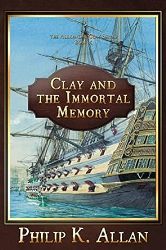
Clay and
the Immortal Memory
by Philip K. Allan
Independently
Published, 2023, ISBN
978-8391106968, US
$19.50 / UK £14.99
Also available in
e-book format
Invasion.
This single word
sums up Emperor
Napoleon Bonaparte’s
most ardent wish: to
claim England as his
own. But the British
Royal Navy blockades
France’s ports and
while he has enough
barges to carry his
troops across the
Channel, he lacks
enough ships of the
line to go up
against this
irritating foe.
During 1804, his
shipwrights build
new ships as fast as
they can. He has
also reached a
secret accord with
Spain that will soon
allow him to
sufficiently
increase his naval
forces. What he does
not have and what he
has no control over
are two elements
that his admirals
deem essential: calm
waters and no enemy
ships. He is
certain, however,
that 1805 will
resolve these issues
and he will have the
victory he desires.
Francois
Brissot is excited
to join the crew of
the 74-gun Redoubtable
at Toulon. He
only hopes she will
not be relegated to
sitting in the
harbor as happened
to his previous ship
because of the
British blockade.
Once aboard, he
finds that many of
the men are new to
the sea, but he has
a way of leading and
training them that
strikes a jealous
chord with the first
lieutenant, Camille
Dupotet. The rivalry
deepens after Redoubtable
fails to elude
the British patrol
blockading the
harbor and Francois
is the only officer
to suggest a
creative way that
might give them the
edge the next time
they confront the
enemy.
Successfully
preventing the
French from
capturing a convoy
from China provides
Captain Alexander
Clay and his men the
opportunity to
return to England.
Monsoon winds are
less accommodating,
requiring him to
venture close to the
French base in the
Indian Ocean. As a
result, the Griffin
is doggedly
pursued by three
enemy ships; an
ingenious ruse
allows him to escape
unnoticed. Once they
are in the Atlantic,
they happen upon a
French fleet and
Clay faces a
dilemma: pursue this
fleet or head to the
nearest British base
to report the
enemy’s whereabouts.
A bit
closer attention to
copyediting would
have corrected some
misspellings, but
these are not
sufficient to
disturb the reader’s
enjoyment of this
tenth adventure in
the Alexander Clay
series. My one
complaint is that
the French
characters speak
more like their
English counterparts
than as Frenchmen.
This tends to weaken
the feel of the
French world they
inhabit.
Allan does
a commendable job
portraying both the
tedium of daily ship
life and the
intensity of those
occasional bouts of
nail-biting action.
He deftly weaves
humor or anguish
into his scenes. One
example of the
former occurs when
one of Sean
O’Malley’s schemes
backfires. One
example of the
latter takes place
aboard Victory at
the Battle of
Trafalgar.
Clay
and the Immortal
Memory is a
tale of Napoleon’s
successful
maneuverings to
strike a devastating
blow against the
British that
eventually
culminates in the
Battle of Trafalgar.
Readers get to view
these events from
both perspectives.
The focus, however,
is on the aftermath
of the clash, which
proves just as
riveting as the
battle. Fans of this
series will enjoy
this latest
adventure.
Review
Copyright ©2023
Cindy Vallar

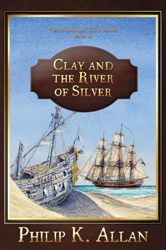
Clay
and the River of
Silver
by Philip K. Allan
Independently
Published, 2024,
ISBN
9798328188555, US
$19.50
Available in other
formats
Following
the Battle of
Trafalgar,
Britain rules
the seas and the
Admiralty
believes the
time has come to
take the war to
the enemy.
Captain Sir
Alexander Clay
suggests taking
the Cape of Good
Hope from the
Dutch, but his
plan requires an
amphibious
attack with the
army taking the
lead. The
squadron
commander for
this worthy idea
will be Captain
Home Riggs
Popham.
Normally, he
would be given
the honorary
rank of
commodore, but
the Admiralty
refuses to do
so. They’re wary
of Popham and
his penchant for
recklessness and
self-aggrandizing.
Clay is to serve
as his deputy to
rein in those
proclivities.
Before leaving
England, Popham
and Nicholas
Vansittart, a
diplomat, meet
with a gentleman
from South
America. He
represents a
group of
patriots within
the Viceroyalty
de la Plata who
seek assistance
in their bid for
freedom from
Spain. He tempts
the two
Englishmen with
a large quantity
of silver
currently
awaiting
shipment to
Spain. The
venture entices
both men for
different
reasons, but the
cabinet never
promises to
support the
rebels. Still,
Popham is not
opposed to
exploring the
venture after
the Cape of Good
Hope is under
British rule.
Vansittart’s
only
reservations
involve the
diplomatic
angles such
intrusion may
impose and he
doubts Clay will
be amenable to
the whole
affair.
Nor does Popham
take the
Admiralty’s
neglect in
elevating him to
commodore well.
It causes
friction between
him and Clay,
and he’s jealous
of Clay’s
successes and
close
connections with
the First Lord.
Still, they must
work together,
first in
southern Africa
and then in
Argentina.
Eventually,
Popham’s
objectives
diverge from
everyone else’s
and Clay and his
men, as well as
the army, pay
the dearest
prices.
Some readers may
find this ninth
offering in the
Alexander Clay
series less
interesting than
previous naval
episodes in the
Napoleonic Wars.
I fall into this
category, and
this is not the
first historical
novel I’ve read
that portrays
these incidents.
What intrigues
me is the
contrast between
Allan’s
portrayal with
his series’
characters and
Julian
Stockwin’s with
his in Betrayal.
Thomas Kydd
plays a more
central role
throughout and
has a personal
stake in his
relationship
with Popham.
Alexander Clay
stays mostly on
the periphery,
and Allan is
clearer in how
the different
events unfold.
He also provides
more from the
army’s
perspective than
the navy. Having
read both
versions, I find
that the two
combined give a
unique and
greater
understanding of
why and how
these historic
events unfolded.
When Clay and
his men are
front and
center, the
scenes are
riveting.
Episodes within
Clay and the
River of
Silver
have parallels
relevant to
situations in
today’s world.
Review
Copyright ©2025
Cindy Vallar


Click to contact me
Background image compliments
of Anke's Graphics |











